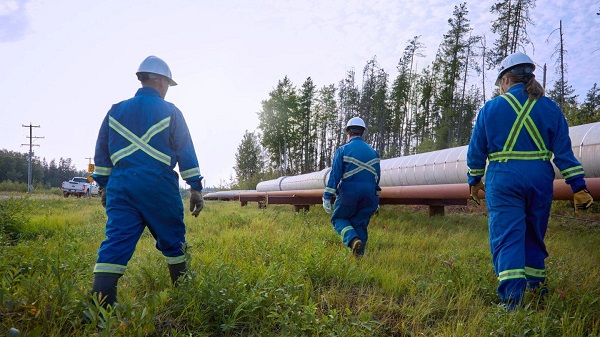Alberta
Canadians in three provinces will spend roughly the same on debt interest as K-12 education

From the Fraser Institute
By Grady Munro and Jake Fuss
From 2008/09 to 2023/24, the federal government is projected to have run deficits every single year, with no interruptions. This has resulted in federal net debt (total debt minus financial assets) increasing by $603.6 billion (inflation-adjusted).
For more than a decade, Canadian governments have increasingly relied on borrowed money to fund their excessive spending habits. However, as debt has continued to pile up so have the costs associated with this debt—namely interest costs. A recent study shows that in some of the largest provinces, governments now spend nearly as much or more on debt interest costs than on K-12 education.
Since the 2008/09 financial crisis, governments across Canada have fallen into the habit of utilizing debt to fund their spending habits. For example, consider the federal government.
From 2008/09 to 2023/24, the federal government is projected to have run deficits every single year, with no interruptions. This has resulted in federal net debt (total debt minus financial assets) increasing by $603.6 billion (inflation-adjusted). Conversely, from 1996/97 to 2007/08, the federal government actually lowered its net debt by $348.1 billion (inflation-adjusted). Clearly, there’s been a shift in the government’s approach towards debt accumulation.
This is not simply a federal problem, as provinces have also seen their debt burdens rise as well. Cumulatively, provincial and federal net debt has increased by $1.0 trillion (inflation-adjusted) from 2007/08 to 2023/24.
Government debt carries costs, primarily in the form of the interest payments, which represent money that doesn’t go towards paying down the actual debt amount, nor does it go towards providing government services or tax relief. And since governments must utilize tax revenues to pay interest, taxpayers are ultimately on the hook for servicing government debt.
But how much do Canadians actually pay in debt interest costs?
Using data from the most recent fiscal updates, a new study compares combined (federal and provincial) debt interest costs for residents in three of the largest provinces (Ontario, Quebec and Alberta) with what those provinces expect to spend on K-12 education in 2023/24. The study utilizes combined debt interest costs because Canadians are ultimately responsible for interest costs incurred by both the federal government and the province in which they live. The following chart summarizes the comparisons from the study.

As is clear from the chart, combined interest costs for residents in these provinces are nearly as much or more than their province expects to spend on K-12 education in 2023/24. Specifically, combined interest costs are $31.5 billion for Ontarians, which is only $3.2 billion less than the province will spend on K-12 education in 2023/24. Combined interest costs for Quebecers ($20.3 billion) will actually exceed the $19.9 billion the province will devote towards K-12 education. And combined interest costs for Albertans are only slightly lower than the $8.9 billion that will be spent on K-12 education.
In other words, taxpayers in Ontario, Quebec and Alberta are paying nearly as much or more to service federal and provincial government debt than they are paying to fund K-12 education in their province. This budget season, it’s important to remember the costs associated with growing government debt.
Authors:
Alberta
‘Existing oil sands projects deliver some of the lowest-breakeven oil in North America’

From the Canadian Energy Centre
By Will Gibson
Alberta oil sands projects poised to grow on lower costs, strong reserves
As geopolitical uncertainty ripples through global energy markets, a new report says Alberta’s oil sands sector is positioned to grow thanks to its lower costs.
Enverus Intelligence Research’s annual Oil Sands Play Fundamentals forecasts producers will boost output by 400,000 barrels per day (bbls/d) by the end of this decade through expansions of current operations.
“Existing oil sands projects deliver some of the lowest-breakeven oil in North America at WTI prices lower than $50 U.S. dollars,” said Trevor Rix, a director with the Calgary-based research firm, a subsidiary of Enverus which is headquartered in Texas with operations in Europe and Asia.
Alberta’s oil sands currently produce about 3.4 million bbls/d. Individual companies have disclosed combined proven reserves of about 30 billion barrels, or more than 20 years of current production.
A recent sector-wide reserves analysis by McDaniel & Associates found the oil sands holds about 167 billion barrels of reserves, compared to about 20 billion barrels in Texas.
While trade tensions and sustained oil price declines may marginally slow oil sands growth in the short term, most projects have already had significant capital invested and can withstand some volatility.
“While it takes a large amount of out-of-pocket capital to start an oil sands operation, they are very cost effective after that initial investment,” said veteran S&P Global analyst Kevin Birn.
“Optimization,” where companies tweak existing operations for more efficient output, has dominated oil sands growth for the past eight years, he said. These efforts have also resulted in lower cost structures.
“That’s largely shielded the oil sands from some of the inflationary costs we’ve seen in other upstream production,” Birn said.
Added pipeline capacity through expansion of the Trans Mountain system and Enbridge’s Mainline have added an incentive to expand production, Rix said.
The increased production will also spur growth in regions of western Canada, including the Montney and Duvernay, which Enverus analysts previously highlighted as increasingly crucial to meet rising worldwide energy demand.
“Increased oil sands production will see demand increase for condensate, which is used as diluent to ship bitumen by pipeline, which has positive implications for growth in drilling in liquids-rich regions such as the Montney and Duvernay,” Rix said.
Alberta
It’s On! Alberta Challenging Liberals Unconstitutional and Destructive Net-Zero Legislation

“If Ottawa had it’s way Albertans would be left to freeze in the dark”
The ineffective federal net-zero electricity regulations will not reduce emissions or benefit Albertans but will increase costs and lead to supply shortages.
The risk of power outages during a hot summer or the depths of harsh winter cold snaps, are not unrealistic outcomes if these regulations are implemented. According to the Alberta Electric System Operator’s analysis, the regulations in question would make Alberta’s electricity system more than 100 times less reliable than the province’s supply adequacy standard. Albertans expect their electricity to remain affordable and reliable, but implementation of these regulations could increase costs by a staggering 35 per cent.
Canada’s constitution is clear. Provinces have exclusive jurisdiction over the development, conservation and management of sites and facilities in the province for the generation and production of electrical energy. That is why Alberta’s government is referring the constitutionality of the federal government’s recent net-zero electricity regulations to the Court of Appeal of Alberta.
“The federal government refused to work collaboratively or listen to Canadians while developing these regulations. The results are ineffective, unachievable and irresponsible, and place Albertans’ livelihoods – and more importantly, lives – at significant risk. Our government will not accept unconstitutional net-zero regulations that leave Albertans vulnerable to blackouts in the middle of summer and winter when they need electricity the most.”
“The introduction of the Clean Electricity Regulations in Alberta by the federal government is another example of dangerous federal overreach. These regulations will create unpredictable power outages in the months when Albertans need reliable energy the most. They will also cause power prices to soar in Alberta, which will hit our vulnerable the hardest.”
Finalized in December 2024, the federal electricity regulations impose strict carbon limits on fossil fuel power, in an attempt to force a net-zero grid, an unachievable target given current technology and infrastructure. The reliance on unproven technologies makes it almost impossible to operate natural gas plants without costly upgrades, threatening investment, grid reliability, and Alberta’s energy security.
“Ottawa’s electricity regulations will leave Albertans in the dark. They aren’t about reducing emissions – they are unconstitutional, ideological activist policies based on standards that can’t be met and technology that doesn’t exist. It will drive away investment and punish businesses, provinces and families for using natural gas for reliable, dispatchable power. We will not put families at risk from safety and affordability impacts – rationing power during the coldest days of the year – and we will continue to stand up for Albertans.”
“Albertans depend on electricity to provide for their families, power their businesses and pursue their dreams. The federal government’s Clean Electricity Regulations threaten both the affordability and reliability of our power grid, and we will not stand by as these regulations put the well-being of Albertans at risk.”
Related information
- Conference Board of Canada socio-economic Impacts of Canada’s 2030 Emissions Reduction Plan – (April 2025)
- Alberta Electric System Operator’s position on Canadian Energy Regulations
-

 Alberta1 day ago
Alberta1 day agoIt’s On! Alberta Challenging Liberals Unconstitutional and Destructive Net-Zero Legislation
-

 Business2 days ago
Business2 days agoChina’s economy takes a hit as factories experience sharp decline in orders following Trump tariffs
-

 Automotive2 days ago
Automotive2 days agoNew federal government should pull the plug on Canada’s EV revolution
-

 Business2 days ago
Business2 days agoTrump’s bizarre 51st state comments and implied support for Carney were simply a ploy to blow up trilateral trade pact
-

 Business2 days ago
Business2 days agoScott Bessent says U.S., Ukraine “ready to sign” rare earths deal
-

 International2 days ago
International2 days agoJavier Millei declassifies 1850+ files on Nazi leaders in Argentina
-

 Alberta1 day ago
Alberta1 day agoAlberta’s future in Canada depends on Carney’s greatest fear: Trump or Climate Change
-

 Business2 days ago
Business2 days agoNew federal government plans to run larger deficits and borrow more money than predecessor’s plan



